Summer Scourges (Sun and Surf)-A Photo Essay
Images of guttate hypomelanosis, jellyfish sting, basal cell carcinoma, cercarial dermatitis (swimmer’s itch), epidermal growth factor receptor inhibitor photosensitivity (sunburn), seabather’s eruption, and squamous cell carcinoma.
Guttate hypomelanosis, attributable to long-term sun exposure, is seen frequently on the forearms and shins of women older than 40 years. It is differentiated from the depigmentation that is characteristic of vitiligo, which has a predilection for periorifacial and genital areas. Tinea versicolor, which is associated with scale, usually arises on the trunk. Some healed factitial lesions feature depigmentation caused by scarring, which was absent on this patient. Cutaneous drug reactions usually are more diffuse than this patient’s rash; hormone replacement agents, also a possible suspect, are not photosensitizing.
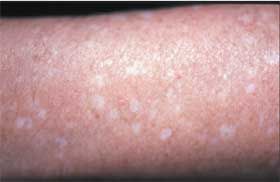
Image courtesy of David L. Kaplan, MD.
Click here for the next image
While scuba diving in the Philippines, a healthy 36-year-old man noticed a red rash localized to his wrists and dorsa of both hands after he surfaced from a dive. The rash soon became painful, swollen, itchy, and papular. He had brushed against multiple small white jellyfish, which suggested that he had been stung. Jellyfish sting causes immediate burning, numbness, inflammation, and paresthesia. Linear papules or wheals develop where the tentacles come in contact with the skin.
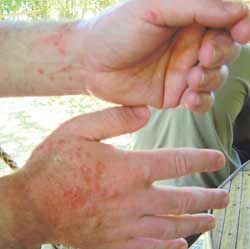
Image courtesy of Tanya Gold, MD.
Click here for the next image
A 47-year-old man noted the recent onset of an asymptomatic lesion on his upper arm. He had been employed as a construction worker in Houston for several decades and denied the use of sunscreen. The smooth and translucent nature of this nodule suggested the correct diagnosis, basal cell carcinoma. There was some heavy pigmentation to the lesion that might, justifiably, suggest a diagnosis of melanoma. Basal cell carcinoma can be variably pigmented, especially when the patient’s skin tone is dark.
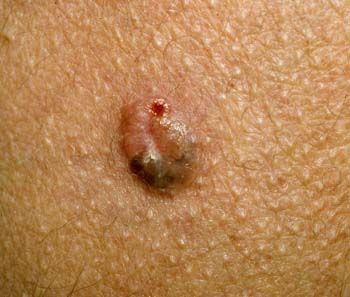
Image courtesy of Ted Rosen, MD.
Click here for the next image
An 11-year-old boy presented for evaluation of an erythematous, pruritic, papular rash that developed after swimming in a Wisconsin lake. He was otherwise completely healthy. The boy had cercarial dermatitis (swimmer’s itch), a hypersensitivity reaction that occurs after exposure to schistosome larvae in freshwater lakes. Outbreaks are most common in the Great Lakes region of the United States but occur during summer months throughout the world.
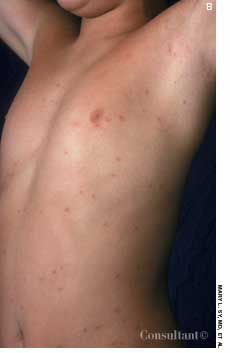
Image courtesy of Mary L. Sy, MD and Gary P. Williams, MD.
Click here for the next image
Increased sensitivity to ultraviolet radiation, manifested as sunburn, may occur when patients are treated with a variety of different pharmaceutical agents. This patient has epidermal growth factor receptor inhibitor photosensitivity. Applying broad-spectrum sunscreens (containing zinc oxide or titanium dioxide) with a sun protection factor higher than 30 is critical for any patient receiving drugs that increase photosensitivity.
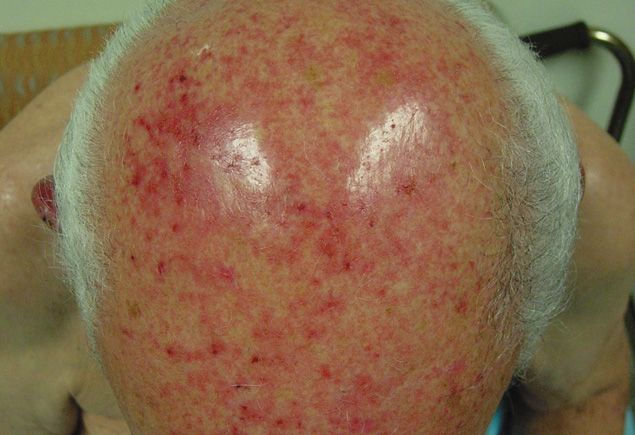
Image courtesy of Mario E. Lacouture, MD.
Click here for the next image
A traveler in Cuba experienced seabather’s eruption, referred to locally as “El Caribe.” Seabather's eruption is a pruritic dermatitis caused by a hypersensitivity reaction to the free-floating immature nematocysts of larval-stage thimble jellyfish sea anemones, and other larval cnidarians. After vinegar was applied, the pruritus and burning diminished almost immediately. Topical application of vinegar is supported only by frequent anecdotal reports of its effectiveness. Caution swimmers not to use vinegar to try to remove the jellyfish larvae from the skin immediately after they get out of the water-that may only trigger the envenoming barb-firing mechanism and precipitate the eruption. Removing swimwear and showering should be the first step.
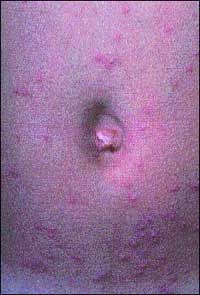
Image courtesy of Mary L. Sy, MD and Gary P. Williams, MD.
Click here for the next image
The tender, crusted nodule on the lip of a 35-year-old man with a history of extensive sun exposure had been growing slowly for 6 months. He had squamous cell carcinoma. Chronic exposure to the sun plays a dual role in the development of basal cell and squamous cell carcinomas. UV radiation causes cellular DNA mutations that can progress to form tumors and prevents the cutaneous immune system from rejecting tumors. Metastases develop in up to 10% of patients who have had squamous cell carcinoma of the lip. Encourage the use of sunscreen on all sun-exposed skin, including the lips.
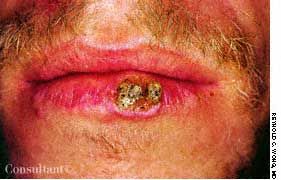
Image courtesy of Reynold C. Wong, MD.
Click here to return to the first image.